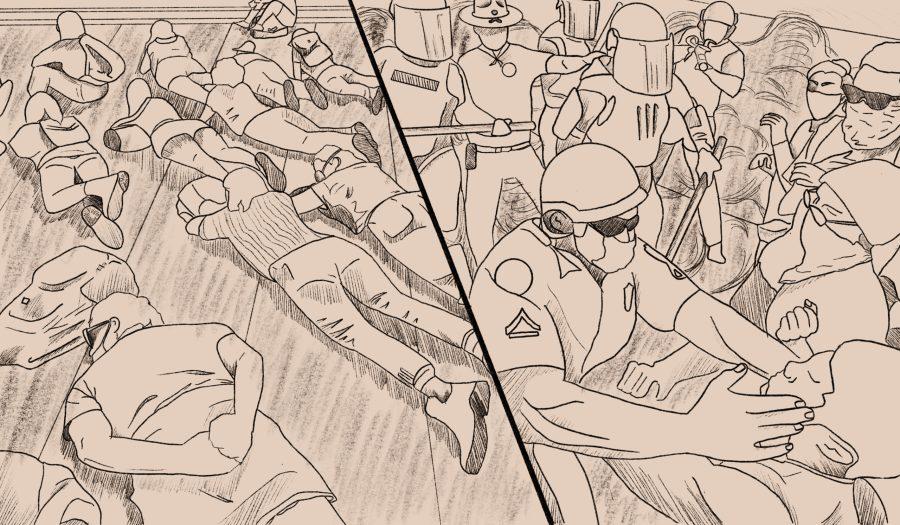Violent and peaceful protests against structures and policies can easily be seen as a black-and-white moral issue, but they are both employed as strategies with varying consequences. Violent protests, also, do not necessarily stem from a will to be chaotic as much as they are dubbed a justified means for better policies or a method of self-defense.
In an idealized society, citizens in a democracy employ their right to respond to an injustice or an unjust government by peacefully protesting for better policies, which they then receive. When protests in a democracy turn violent, the lines become blurred as to who is culpable and if violence truly is never warranted. But peaceful and violent protests aren’t a black-and-white moral issue as much as they’re strategies and tools of solidarity utilized in different stages or times of the protest.
Still, the avoidance of protests or demonstrations can oftentimes be appealing. For example, the multi-college system in UC San Diego carried goals to develop more solidarity and close-knit bonds among students. But some remark that the spacing of the colleges helps disperse protests and maintain order amongst the student population. This is due to the perceived distance between each of the seven colleges from each other and lack of one localized area (though there is Geisel Library). In fact, the multi-college system began expanding during the time of the Civil Rights movement where protests at other schools like UC Berkeley were taking place. UC Berkeley was a mecca of protests, starting from verbalized protests on free speech to some more hectic riots during the Vietnam War.
The view that protests must stay unconditionally peaceful is often perceived as ignorance or loaded language today. This response echoes some who state that the violence of oppressed can never outweigh the violence of the oppressors. While protests are not forbidden in democratic governments, they can wade into tricky territory if they — on occasion — turn violent.
Staff writer for The New Yorker, Isaac Chotiner, conducted an interview on protests surrounding police brutality in the U.S. with assistant professor Omar Wasow, who opts to use the terms “nonviolent protest” or “violent protest” over “riot.” Wasow, who taught politics at Princeton University, examined the shift from civil rights victories to today’s law-and-order politics for years. Interestingly enough, Wasow said that a concerned public and media attention go hand in hand, which is effective for nonviolent protests.
However, if protests turn violent, this is good material for the opposing side as well as for the issue to refocus as a crime problem above one on justice. He does say that violent protests also capture more media attention than peaceful protests. In the interview that’s now almost two years old, Wasow goes on to state that the police force usually treats Black protestors — compared to white militias — with excessive force, which invokes the opposite response police want: more chaos. Ultimately, Wasow sees the ideal protest tactics as methods one can derive the most from. Though both nonviolent and violent protests can potentially advance activists’ interests, he states that nonviolent protests for police brutality can still achieve much without dividing political parties.
Outside of the U.S, in Sri Lanka, millions of people are currently dealing with power cuts and problems with expensive fuel and food. They began protesting in the streets around March, upset with the economic mismanagement they attribute to President Gotabaya Rajapaksa. Rajapaksa — once a popular candidate but now regarded as notorious — states that these crises are a problem. But rather than step down, he promised to address the problem that he attributes partly to the COVID-19 pandemic.
In one protest miles from Colombo, Sri Lankan police employed live ammunition on some protestors for blocking a railway. In protests, they’ve used tear gas and water cannons, too. As of May 4, one person has died — most likely from the gunshot injuries — and 12 others have been injured. However, the protests have mostly been peaceful, with many individuals denouncing the police’s involvement. Though no video evidence indicates that the protestors were being violent, some police stated otherwise and that they had to step in.
The big issue isn’t the overt violence of the government as much as it is the millions of lives that feel threatened by lack of effective action. Additionally, Rajapaksa implemented antiterror laws and jailed critics in response to criticism. However, this event calls to mind at what stage — if at all — individuals feel emboldened to utilize more physical methods to get their demands met.
An event such as the shooting of protestors can be an ideal place for many to begin stoking the fire. On the same note, when Wasow brought up the Civil Rights protestors of the ‘60s, he brought up the tragedy of the injuries (or deaths) at the hands of the state but also the effectiveness of the protestors then receiving more positive attention like sympathy. This also calls to mind how successful peaceful protests have been in democracies, as Rajapaksa still has not stepped down from his position as president amidst the largely peaceful but critical protests thus far.
In his work “Revolution Against Non-Violent Oppression,” Zsolt Kapelner of Central European University addresses the argument of restrictive — but not physically violent — governments not being liable to a revolutionary attack or response. He doesn’t agree with it. In other words, the more responsible the government is, the more proportionate it can be to defensively harm it. He believes that even a stifling government warrants a response from people such as a revolutionary attack; the response is sometimes proportional to the harm citizens feel. Zsolt explores how non-violent governments, through methods like censorship or oppressive legislation — which Sri Lanka at times faced — can still invoke a violent reaction from the people.
Martin Luther King, one of the most important leaders of the Civil Rights Movement, represents a voice of peace with six key principles in his idea of nonviolence. Conversely to Zsolt, his principles include opposing the evil above the wrongdoer and never being physically violent or internally hateful.
Judith Butler, a professor on Comparative Literature at UC Berkeley, is known for their works on gender theory and philosophy. In a similar vein, they are a strong proponent of nonviolence, as perhaps hinted by their recent book “The Force of Non-Violence.” Despite seeing how many groups from antiwar or feminist movements are nonviolent, Butler recognizes how unrealistic many think nonviolence is. But Butler stands by their viewpoint on radical equality and interdependence, in which they see the importance not just in themself but social relations with others as well. They connect social equality to the tool of nonviolence, which they call a political ethic.
By acting violently, one breaks a relationship that defines oneself. Butler does not reject revolutionary violence, but they do note the importance of posing a question of if it will reproduce or if the action makes for a better world. They also do not side with colonial powers or powerful structures that rely on impoverished people or violence amongst communities. In their book, they state that “to boycott a regime that continues colonial rule, intensifying dispossession, displacement, and disenfranchisement for an entire population, is to assert the injustice of the regime…” Though they deem nonviolence a pathway to equality, some believe that Butler’s perspective is daunting or infeasible.
Barbara B. LaBossiere from Public Affairs Quarterly states that times have changed from King’s era of non-violence and an acceptance of all legal consequences of civil disobedience. They state that civil disobedience — or the willful rejection of certain policies — does not have to be nonviolent. LaBossiere believes that if minority grievances are taken with a grain of salt, their violent acts may be “just as morally and politically defendable as those of our past revolutionary heroes,” referring to big U.S. events of the past centuries. Like Zsolt, they consider the justifiability of harming the oppressor, stating that people have the right to bring an issue to the attention of the nation with violence depending on how much those in power do not address the outraged.
LaBoissiere also states that when the government used force to control disorder in the past, it created desperation and a violent, self-defense response. In a startling claim, they assert that “the whole point to civil disobedience is to defy the law in order to expose its injustice.” Because peaceful protests would not usually do this, this comment implies that violence may also serve as a symbolic or necessary means that outweighs lawfulness.
David Hardiman wrote an article on non-violent resistance in “Economic and Political Weekly,” stating that violent revolutions must constantly be sustained and non-violent action encourages dialogue as well as more allies. Hardiman, who is an Emeritus professor at the University of Warwick, states that according to a recent survey of campaigns from 1993–2006, non-violent movements have increased over time, as have their success rates.
There is undoubtedly much merit in peaceful protests. For many individuals, though, this gets blurry when they don’t receive the justice they deem necessary and when governments start to engage in violence. Oftentimes the question can turn into a “who started it?” issue which pits protestors against the government and encourages picking sides. Some say that violence is absolutely never the response or an initiative to take. Others believe they act in self-defense against an oppressor.
Perhaps peace is always the moral high ground, but some individuals won’t take it. This isn’t because they necessarily crave violence. Rather, violence has sometimes been the trigger behind change or as simple desperation to the lack of government change.
Art by Ava Bagley for the UCSD Guardian.

















Nicole Manley • Jul 15, 2022 at 7:09 pm
This was such an interesting, thought-provoking, well-written article. It made me question a lot of my beliefs, and I’ll keep on researching and formulating new opinions with new knowledge. The author provided such a balanced, nuanced view that I feel all sides were respected. I also hadn’t heard of the protests in Sri Lanka until reading this piece, which I’m very grateful for learning, and I plan to read more. Thank you for writing this!
John Jeremiah Conroy • May 13, 2022 at 10:49 pm
I look at violence and riots from a differant persoective . Riots and violence just dont simply happen because people crave violence for the sake of violence. Violent protests that turn into riots is caused through the number of years of build up tension over issues that have been totally ignores and nothing done about it. A excample police brutality and misuse of authority has been going on for years and years long before George floyd rodney and rodney king. Look at watts riots 1965. Rodney king riots 1992. George floyd riots 2020. Years of build up of tension of racism.
poverty homelessness. Jobless inflation. Outdated policies that arent working authorirarianism of the goverment stepping over freedoms liberties and the constitution etc etc. Throughout time the time bomb explodes over a period of time. George floyd riots in 2020 didnt just happen over night. Their was already in 2019 racial tension and police brutality and bad policies building plus in 2020 covid 19 lockdowns of shuttinv the country down with joblessness lay offs homelessness unemploymenr forced mandates against our freedoms and liberties and constitutions and forcee stay home orders with the a whole country shut down and protests against covd Mandates with all this builded up tension all it took was the george floyd protests and civil unrest oc Riots all over the country to spark up major change through a period of time more issues and tensions will build up to continous revolutionary change of continued protests and Riots to continue throughout 2022 through 2030.. and beyond. The 1960s was major revolutionary change. Just as the 2020s will be a total differant major change this time diffreant from.the 1960s. Violence and riots dont happen for the sake of riots and violence alone. Violence and riots have been the american revolutionary of life . The civil war of America and world war 1 and worls war 2 were violent. The vietnam war and the persian gulf war was violence. Not just america but history shows protests and violence and rioting in other countries just as it is happening today 2022. I am just pointing out that protests that are peaceful and turn into riots has another angle and side of it. Yes i do not condone rioters to destroy local small busineeses and cities being burnt down to the ground and killing people just to be killing people and just to destroy like antifa. I think we should look at rioting and violence from all differant angles
Daphne Galang • May 13, 2022 at 5:33 pm
The feature article entitled “How Violent Protests Gain Traction” by Yuyang Zhou was published in the May 9, 2022, UCSD Guardian on page 9. Although it included examples of protests from international and American history, the article omitted several important issues. First, “protest” is not the same as “peaceful assembly”. The United States Bill of Rights gives us freedom to assemble, and freedom of expression, but it does not give us unlimited freedom from responsibility for our actions. In many laws, violence is associated with crime. Crime should be condemned not condoned. In leadership studies, a leader is fundamentally defined as “a person who people will follow”. However, when people have to be forced or coerced into obedience, the people are not willingly following the leader anymore. Resorting to violence means that the leader is not effectively leading the population and may be losing power. Beware that becoming a “violent protester” makes the participant as violent as the enemy. No one wins and everyone loses. Respectfully, Daphne Galang